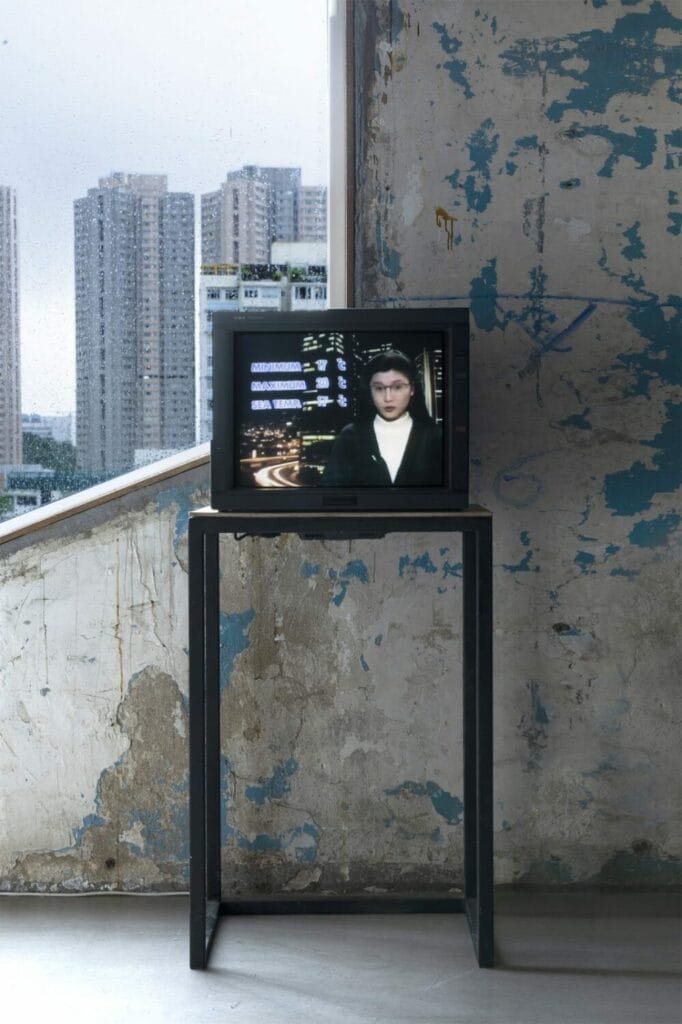Scene 3 of Play and Loop III will feature the works Cranial Relic (2020) and Harvest from Atlantis (2019) by Tita Salina & Irwan Ahmett, and Fate-calculating: Get Yale Interview Prepared (2010), Feng Shui: how to be a better artist (2011) and Yes-Jet-Lag (formula 2.0) (2021) by Wong Kit Yi.
Tita Salina and Irwan Ahmett, an artist duo from Indonesia, take apart the conflict and violence of hegemonic powers in human history in Cranial Relic (2020). Relics — objects that narrate a time of the past are dropped by hand, and with gravitational force strike the body. A colonial Dutch East Indies coin celebrates the expropriation of native Indonesian resources under European rule; a bullet fired in the Indonesian student protests in 2019 silences the desire for democracy and freedom; and an animal’s tooth arouses our instinctual fear against biodiverse coexistence.[1] These relics inflict pain and the vulnerable skin bears it. In a time where fear lingers more than ever, our innate flight or fight mechanisms wired into our primal reptilian brain are constantly triggered in the name of “protection” and “security”. Human nature’s cyclical patterns of rivalry will only render these modern tools of oppression into relics of the same ominous fate, repeating across pre-historic, colonial and post-modern times.
Harvest from Atlantis (2019) follows the 7-month journey of mussel cultivation in Jakarta Bay. Amongst the littered and barren village, Tita Salina and Irwan Ahmett stage a ritualistic ceremony by parading and planting a monumental bamboo structure used for harvesting mussels is out into the expanse of the sea. Over the months, petal offerings bless and foster the mussel tree’s cultivation before finally yielding an abundant harvest and brought home. As household waste and heavy metals from industrial plants continue to contaminate the waters, groundwater extraction pose a huge problem as land subsidence and rising sea levels cause Jakarta to sink at an alarming pace. Amid ecological ruin under unchecked capitalism, these small coastal communities hold on to the sea as a site for collective living and striving as they have for generations. One day, even when submerged, the mussel trees of Jakarta-Atlantis will serve as monuments of resistance and regrowth from below ground.

In 2010, Wong Kit Yi’s presented Fate-calculating: Get Yale Interview Prepared (2010) at her Yale MFA programme admissions interview. The video sees her visiting a Chinese fortune teller to predict her fate at the interview. By removing the agency from her own hands, Wong attempts to debunk institutional structures and the myth of the artistic genius. As predicted by the fortune teller, Wong gets accepted into the programme.
Feng Shui: how to be a better artist (2011) follows Wong to her new studio space at the Yale Sculpture Building. She invites feng shui master Mr. Ye to read the harmonisation between her and her studio, hoping it will enable her to become a better artist. He instructs her on multiple spatial interventions such as placing a yellow carpet in one side of the room, to avoid sitting in the corner of death and triumphantly reassuring her that her chosen studio 403 is a prosperous number, sharing similar intonations to the Chinese words for “even in death, you’ll revive”. To some, the superstitious practices of feng shui may appear absurd, but many would not hesitate to make the same statement about the irrationalities of the art market and its auxiliary institutions. Wong’s geomancy and pseudoscience tap into the innate human desire for meaning and direction, charting a post-humanist pathway against Enlightenment institutional ideologies purported by prevalent neo-liberal systems.
Wong Kit Yi’s newest work Yes-Jet-Lag (formula 2.0) (2021) explores the phenomenon of jet-lag and the spatial temporal displacement the body experiences. In a time where travel bans restrict the crossing of time zones, video call technologies force us to reverse our logic on what it means to be in sync with time. Comparing jet-lag to a witch’s broomstick flight, Wong delves into hallucinatory possibilities of disruptions in our circadian rhythm. Using her karaoke style lecture to present her pseudoscientific endeavours, she places an acute awareness and fixation to the timing of on screen subtitles, inviting us to redefine the reality of the present, whilst being governed by our construct of time.

On view in the gallery throughout the eight weeks of Play and Loop III are time-based installations of three artists. Carla Chan’s Space between the light fades (2021) is an animated lightbox showing an ethereal halo ebbing and flowing like a hallucination, or the afterimage of staring into sunlight. Tiffany Sia’s A Wet Finger in the Air (2021) is a randomized infinite loop of bilingual weather reports from 1980-90s Hong Kong TVB station, attempting to capture the prevailing dynamics in a city despite rapidly shifting weather trends. Luke Ching Chin Wai’s Quarantine Hotel (2021) is an installation of objects and slideshow of images from the artist’s recent 21-day quarantine in Hong Kong, where in purgatory idleness the artist turns his chamber into a temporary camera obscura, projecting the off-limit outside world into an interior landscape. Like all of us stuck in the past year, these artists have been daydreaming out of the window into light, incessantly following news reports, and earnestly reveling in a little world despite.
As part of the programme for Play and Loop III, Wong Kit Yi will premiere her lecture performance of Yes-Jet-Lag (formula 2.0) on 21 August 2021, 4:30pm at Blindspot Gallery. An artist conversation between Wong Kit Yi and John Tain, head of research at Asia Art Archive will be held after the performance and moderated by Nick Yu.
[1] Irwan Ahmett & Tita Salina, ‘Cranial Relic: Eleven Artifacts on Extinction and Survival since 1.5M Years’, Terremoto, November 30, 2020, https://terremoto.mx/en/revista/reliquia-craneal/ (accessed August 7, 2021).
Blindspot Gallery ????
15/F, Po Chai Industrial Building
28 Wong Chuk Hang Road
Wong Chuk Hang, Hong Kong









